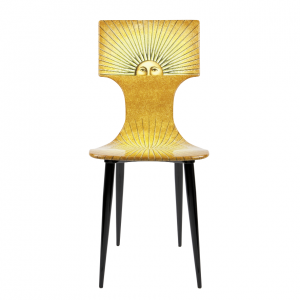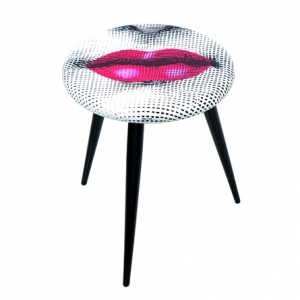by Barnaba Fornasetti
There’s almost certainly in all of us a childish side and in the works of my father this childlike desire to play comes out. This is the reason why the works of Fornasetti appeal to the simplest of minds, those minds that have freed themselves from cultural stereotypes. The minds of children or the humblest of individuals who do not possess a culture in the conventional sense of the term are drawn to Fornasetti, not merely only those people who have been culturally educated. I have witnessed workers set aside a small part of their already meagre salary in order to – step by step and bit by bit – be able to by one of our objects.
On the other hand, there are people who aren’t even aware of Fornasetti even though the works by the artist often verge on the showy and ostentatious. Then, again, there are others who are horrified by his works and claim that they are imbued with bad taste. These latter are, needless to say, superficial types who are unable to see how much research – full of good taste! – goes into the creation of these works, the attention paid to their design, to the right balance between decoration and form, to the colour, all tinged with a subtle layer of irony that these individuals find it so hard to understand.
You either like or you either hate Fornasetti and I have to say, at this point, that the ranks of those that love his works are getting larger and larger and, more importantly, his work is increasingly characterised by a growing, greater “loyalty”. People who begin to collect Fornasetti, who start entering into the artist’s world of fantasy, become bewitched with his works and stay with him over time.
There is a multitude of reasons why you should approach and enter into the world of Fornasetti. As well as those reasons already mentioned that regard more the emotional dimension there are also reasons that are much more practical. My father claimed that an object or a piece of furniture should – as their very existence suggests – not lose their initial and original functions. It might be so completely decorated to the very extremes of excess but it must not lose its function: “a chair is made for sitting upon and, before all else, it has to be comfortable”. Piero Fornasetti managed, apart from actually designing a chair, to pour into it cultural, ironic and media-oriented significances, to apply art to objects that were of daily and domestic use and to gladden our daily lives. He said that he strove to communicate a certain joie de vivre. What is a more contemporary thought than that in a world that is increasingly grey, uniform and mundane?
We need our eyes, during those rare moments they stop and look, to enjoy evocative images like looking at a view, a garden, a work of art or something that will satisfy our own inner aesthetic taste.
What I think is important, just as he also used to think, is that Fornasetti is timeless. He can’t be identified by any one style and is, indeed, “transversal”. He invented a way to create objects that used both styles as well as eras and he was able to mix them with good grace and irony thus creating objects that were always contemporary. In a certain sense, he foresaw in design what Disc Jockeys do today in music – a mix of cultures that are wholly now. I like quoting a sentence by Bruno Munari that I feel is utterly ingenious and explanatory “Fornasetti may be measured solely on a scale of Fornasetti”.















